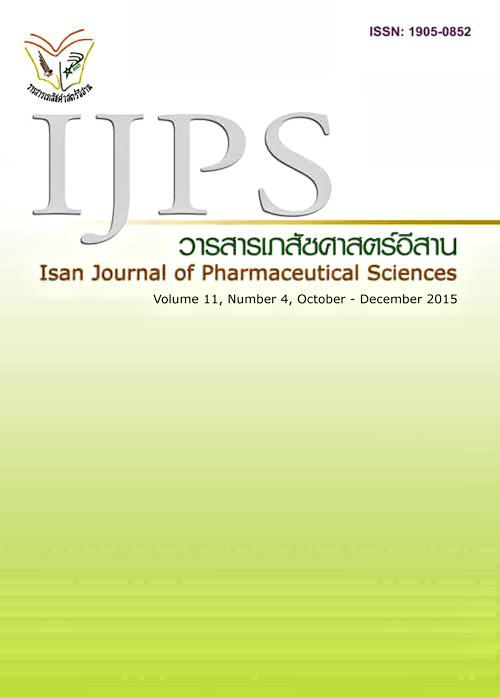Microemulsion Development for Enhancing the Stability of Green Tea (Camellia sinesis) Extract
Main Article Content
Abstract
The aim of the research study was to develop the microemulsion formulation for enhancing the stability of catechins, the main constituent in green tea extract. Based on the single isotropic region produced in the pseudoternary phase diagram, the effects of the surfactant mixtures (Span80: Cremophor RH40; Span80: Kolliphor EL and Span80: Kolliphor HS15 [1:1]) on the phase behavior and the concentrations of cosurfactant (isopropanol, IPA), oil phase (jojoba oil) and water in the systems were evaluated. The selected microemulsion systems were investigated in terms of characteristics, such as clarity, droplet size, polydispersity index (PI), conductivity, pH and viscosity. The stability tests of microemulsion were also performed for the further optimization of the system. The results indicated that the clear w/o microemulsion containing the mass of 0.5% green tea extract, 49.90% surfactant mixtures consisting of Span80 and Cremophor RH40 at the ratio of 1:1, 24.31% jojoba oil, 25.29% water to IPA ratio 1:1 remained stable during storage and exhibited the droplet size in microemulsion range, low viscosity, acceptable pH and conductivity. Transmission electron microscope (TEM) was used to image the microemulsion droplets and revealed the spherical feature of the particles. Furthermore, the percentages of the remaining active constituents, caffeine, epicatechin and epigallocatechin gallate, in the optimized microemulsions after stability test were analysed by the developed HPLC method in comparison with the prepared green tea extract gel. It was found that the optimized microemulsions contained the contents of these three active compounds significantly higher than the prepared green tea extract gel after storage at room temperature up to 3 months and 6 heating/cooling cycles. It could be concluded that the developed microemulsion system significantly enhances the stability of green tea extract.
Article Details
In the case that some parts are used by others The author must Confirm that obtaining permission to use some of the original authors. And must attach evidence That the permission has been included
References
Cabrera C, Artacho R, Gimenez R. Benefi cial Effects of green tea: A review. JACN 2006; 25(2): 79-99.
Chansiri G. Pharmaceutical emulsions. Nakhon Pathom: Silpakorn University; 2006. 147-148.
Fang JY, Hwang TL, Huang YL, Fang CL. Enhancement of the transdermal delivery of catechins by liposomes incorporating anionic surfactants and ethanol. Int J Pharm 2006; 310: 131-138.
Fouad AS, Basalious BE, EL.Nabarawi AM, Tayel AS. Microemulsion and poloxamer microemulsion-based gel for sustained transdermal delivery of diclofenac epolamine using in-skin drug depot: in vitro/in vivo evaluation. Int J Pharm 2013; 453: 569-578.
Gadkari VP, Balaraman M. Catechins: Sources, extraction and encapsulation: A review. Food Bioprod Process 2015; 93: 122-138.
Garti N, Shevachman M, Shani A. solubilization of lycopene in jojoba oil microemulsion. JAOCS 2004; 81(9): 873-877.
Gupta S, Sahni JK, Ali J, Gabrani R, Dang S. Development and characterization of green tea loaded microemulsion for vaginal infections. Adv Mater Lett 2012; 3(6): 493-497.
Hong YH, Jung EY, Noh DO, Suh HJ. Physiological effects of formulation containing tannaseconvertd
green tea extract on skin care: physical stability, collagenase, elastase and tyrosinase activities. IMR 2014; 3:
-33.
Junyaprasert V. Nanotechnology: Skin delivery of drugs and cosmetics. Bangkok: Prachachon; 2009. 129-166.
Kantarci G, Ozguney I, Karasulu Y, Arzik S, Guneri T. Comparision of different water/oil microemulsions containing diclofenac sodium: preparation, characterization, release rate and skin irritation studies. AAPS PharmSciTech 2007; 8(4).E1-E7.
Khamtawee C, Ruangratwanitchaya C. Development of lychee seed extract gel [Senior project]. Samutprakarn. Huachiew Chalermprakiet University; 2011. page 46.
Komes D, Horzic D, Belscak A, Ganic KK, Vulic I. Green tea preparation and its infl uence on the content of bioactive compounds. Food Res Int 2010; 43: 167-176.
Manea AM, Andronescu C, Meghea A. Green tea extract loaded into solid lipid nanoparticles. UPB Sci Bull 2014; 76(2): 125-136.
Patel V, Kukadiya H, Mashru R, Surti N, Mandal S. Development of microemulsion for solubility enhancement of clopidogrel. Iran J Pharm Res 2010; 9(4): 327-334.
Pinkhien T. The development of nanoemulsions containing grape seed extracts from Vitis vinifera cv. Ribier (Pok Dum) and their bioeffi cacy study [Thesis]. Samutprakarn. Huachiew Chalermprakiet University; 2014.
Rashidinejad A, Birch E. J, Sun-Waterhouse D, Everett W. D. Delivery of green tea catechin and epigallocatechin gallate in liposomes incorporated into low-fat hard cheese. Food Chem 2014; 156: 176-183.
Rukmini A, Raharjo S. Hastuti P, Supriyadi S. Formulation and stability of water-invirgin coconut oil microemulsion using ternary food grade nonionic surfactants. Int Food Res J 2012; 19(1): 259-264.
Sang S, Lambert DJ, Ho TC, Yang SC. The Chemistry and biotransformation of tea constituents. Pharmacol Res 2011; 64: 87-99.
Shukla BJ, Patel JS. Formulation and evaluation of self micro emulsifying system of candesartan cilexetil. Int J Pharm Pharm Sci 2010; 2(4): 143-146.
Singhan A. Development of microemulsion for enhancing the stability of green tea (Camellia sinesis) extract [Thesis]. Samutprakarn. Huachiew Chalermprakiet University; 2015.
Thepkorn T. Green tea catechins and storage stability. KKU Sci J 2013; 41(1): 46-55.
Xu J, Fan JQ, Yin QZ, et al. The preparation of neem oil microemulsion (Azadirachta indica) and thecomparison of acaricidal time between neem oil microemulsion and others formulations in vitro. Vet
Parasitol 2010; 169: 399-403.
Zhao X, Liu PJ, Zhang X, Li Y. Enhancement of transdermal delivery of theophylline using microemulsion vehicle. Int J Pharm 2006; 327: 58-64.


